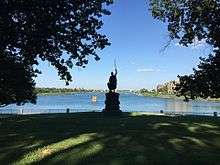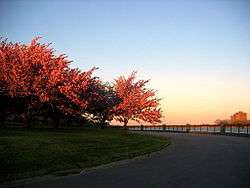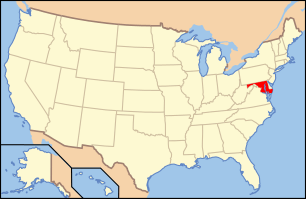Druid Hill Park
| Druid Hill Park | |
|---|---|
| Auchentorlie | |
|
Cherry blossoms along Druid Hill Reservoir | |
| Location | Baltimore, Maryland |
| Created | 1908 |
| Operated by |
Baltimore City Department of Recreation and Parks |
|
Druid Hill Park Historic District | |
   | |
| Location | Druid Hill Park, Baltimore, Maryland |
| Coordinates | 39°19′23″N 76°38′41″W / 39.32306°N 76.64472°WCoordinates: 39°19′23″N 76°38′41″W / 39.32306°N 76.64472°W |
| Area | 746 acres (302 ha) |
| Built | 1860 |
| Architect | Howard Daniels; George A. Frederick |
| Architectural style | Late Victorian |
| NRHP Reference # | 73002183[1] |
| Added to NRHP | May 22, 1973 |
Druid Hill Park is a 745-acre (3.01 km2) urban park in northwest Baltimore, Maryland. Its boundaries are marked by Druid Park Drive (north), Swann Drive and Reisterstown Road (west and south), and the Jones Falls Expressway (east).[2] Inaugurated in 1860, Druid Hill Park, a famed urban park, ranks with Central Park (begun in 1858) in New York City and Fairmount Park (1812) in Philadelphia as the oldest landscaped public parks in the United States.[3]
History
The land was originally part of "Auchentorlie", the estate of Dr George Buchanan (1696-1750), one of the seven commissioners responsible for the 1729 establishment of Baltimore City; Buchanan's country estate included 579 of the 745 acres (3.01 km2) that comprise Druid Hill Park today. Renamed "Druid Hill" by Col. Nicholas Rogers, who married Eleanor Buchanan, it was purchased in 1860 by the City of Baltimore from descendent Lloyd Rogers with municipal funds raised by the revenue derived from a one-cent park tax on the nickel horsecar fares, put through by Mayor Thomas Swann (later Governor of Maryland).[4] After its purchase, Druid Hill Park was inaugurated by Swann on October 19, 1860. It is listed on the National Register of Historic Places. Local residents often refer to the park as "Dru Hill" Park, a "Baltimorese" (local dialect) corruption of its given name.
The park was designed by Howard Daniels, landscape designer retained by the newly created and appointed Board of Park Commissioners, and John H. B. Latrobe, (1803-1891),[5] who designed the gateways to the Park and the alterations made to the early-19th-century Nicholas Rogers mansion that already stood in the site, later known as the "Mansion House". George A. Frederick, (1842-1924), the 21-year-old Baltimore architect who later won the commission for Baltimore City Hall in 1860, (constructed 1867-1875), provided designs for architectural features in the park. Among Frederick's playful structures for Druid Hill in Moorish and Chinese styles is the Chinese Station erected in 1864[2] and the Moorish Station,[6] which were stops on a narrow-gauge railroad that once wound through the park. The "Mansion House" now functions as the main administration building of the Baltimore City Zoo (later renamed Maryland Zoo in Baltimore).
The Park served as an attractive hill for winter sledding during the 1940s, particularly for boys attending the nearby Talmudical Academy of Baltimore.[7]

Like Central Park in New York City's central urban Manhattan of the 1850s designed by Frederick Law Olmsted, (1822-1903), Druid Hill was at the northern edges of urban development at the time of its establishment. The northern end of the park, which contains some of the oldest forest growth in the state of Maryland, has never been landscaped, but rather left as a natural wooded habitat.[2] Roadways through this section of the park have been closed to vehicular traffic since the late 1970s or early 1980s,[8] but have always been open for hikers and bicyclists. A well-known Osage Orange tree, said to be hundreds of years old, was brought down by Storm Sandy in October 2012.[9]
The southern end of the park was a popular destination for city dwellers for a number of decades. Druid Hill Lake, the park's most notable waterway, was constructed in 1863 and remains one of the largest earthen dammed lakes in the country.[2] With the advent of automobiles, the park's many winding roadways became popular with car dealers who took potential buyers there to teach them to drive.
Many of the park's older fountains and man-made ponds have been drained, allowing nature to reclaim those areas. However, many of their structures remain partially or completely intact.[8]
Druid Hill Park was listed on the National Register of Historic Places on May 22, 1973.[1] The Park is also included in the newly organized Baltimore National Heritage Area in the 2010s in cooperation with the National Park Service of the U.S. Department of the Interior.[10]
Racial segregation
When the Park first opened in 1860, recreation facilities such as pools and tennis courts were racially segregated. This practice was finally challenged on July 11, 1948, when 24 black tennis players, protesting the City's discriminatory policies, were arrested for playing on the park's "white-only" tennis courts. The names of the protestors are commemorated on the Baltimore Tennis Club Marker, located adjacent to the Conservatory along Druid Park Lake Drive. The incident was the subject of the last public column and editorial of the famed Baltimore editor, reporter, columnist and author, H.L. Mencken, who, writing in the Baltimore Sun in 1948, condemned the City's segregationist policies.[11]
Festivities

The Druid Hill Farmers' Market is located at the Howard P. Rawlings Conservatory in Druid Hill Park. When open, it offers free programming each week, including concerts, children's activities, yoga classes, plant workshops, art workshops, hay rides, hula hoops, 4-H Workshops, and more. The market runs weekly from June through September.
The Annual "Stone Soul Picnic" has been held at Druid Hill Park since 1991, by the African-American community of the City. The event is free to the public, and consists of food, face painting, music, and cultural art. During summer 2010, recording artists such as Cali Swag District, Bobby V., Marques Houston, and Jazmine Sullivan performed. Another free event held yearly at Druid Hill Park is The Annual Caribbean Carnival Festival. The Caribbean American Carnival Association of Baltimore sponsors the event. The event lasts for three days, consists of food, Caribbean art, Soca, live reggae bands, and costumed dancers.[12][13]
The Park also is the venue for the annual Charm City Cyclocross bicycle race in mid-September, which is one of the major cyclocross bicycle races on the East Coast of the United States.[14]
Since 2014 the annual Charm City Folk and Bluegrass Festival is held each April, next to the HP Rawlings Conservatory and Botanical Gardens.
Health
In 2007, the city of Baltimore spent $50,000 on exercise equipment for the park. The park consists of three workout stations around the park reservoir. The workout machines in the park are free for the public. These stations have rowing machines, elliptical, and leg presses. Many of the exercise machines are manually operated. By the end of 2010, the city of Baltimore plans to install more outdoor exercise equipment for other parks in the city.[15]
Monuments

There are many different monuments in Druid Hill Park. The Wallace Monument, for example, honors fourteenth-century Scottish hero and rebellion chieftain William Wallace. The statue, at least 40 feet tall, is the most recognizable monument in the park. The Wagner Monument, dedicated to the German composer, stands on the lawn near the Mansion house ("Druid Hill" mansion). The monument in honor of Christopher Columbus lies within a view of the main South Driveway, and looks out upon the reservoir. The statue of George Washington (removed from old Carroll Hall building from the mid-19th century at the southwest corner of Calvert and Baltimore Streets in downtown) is placed at an intersection near the Rotunda driveway.[16]
Housing
Druid Hill Park is not home to any private residences, according to the official neighborhood boundaries by the city government of Baltimore.[17] However, the Mansion House, located in The Maryland Zoo, which was built in 1801, served as the estate for Colonel Nicholas Rogers and his family until it was converted into a public pavilion in 1863.[18] The only privately owned properties that are somewhat submerged into the park are at the northeastern corner of the park. This small enclave is the Brick Hill historic district dating to 1877, made of small masonry as well as stone duplexes, where those who worked at the Meadow Mill of the Woodberry Manufacturing Company lived. However, this is considered to be a part of the Woodberry neighborhood.[17][19] Many homes face the park in the neighborhoods of Hampden, Liberty Square, Park Circle, Parkview Woodbrook, Reservoir Hill, and Woodberry. The Achentoroly Terrace, which faces the neighborhood in the Parkview Woodbrook neighborhood, is a historic district of nine blocks built between 1876 and the 1920s in the Victorian style.[20]
Features

Today, the park is home to a number of attractions. These include:
- The Maryland Zoo, (formerly the Baltimore City Zoo)
- The Howard Peters Rawlings Conservatory and Botanic Gardens of Baltimore, with its historic Palm House and Orchid Room, built in 1888.
- An 18-hole disc golf course with 15 additional holes in the woods and another 18-hole wooded course under construction
- Several tennis courts open to the public and local tournaments
- The Baltimore Model Safety City (where school children learn how to be safe pedestrians by walking in a miniaturized model of downtown Baltimore)
- Jones Falls Trail, a hiking and bicycling trail, leaves the Jones Falls at the Woodberry Light Rail Station to enter the north end of Druid Hill Park. It then runs along the west side of the park, before it circles Druid Hill Lake and exits at the southeast corner, where to continues to follow the Jones Falls south.[21]
Notes
- 1 2 National Park Service (2010-07-09). "National Register Information System". National Register of Historic Places. National Park Service.
- 1 2 3 4 "Druid Hill Park" Baltimore Department of Recreation and Parks. Retrieved 2010-10-04
- ↑ Elizabeth Jo Lampl (June 1997). "National Register of Historic Places Registration: Druid Hill Park Historic District" (PDF). Maryland Historical Trust. Retrieved 2016-03-01.
- ↑ Farrell, Michael R. (1992). The History of Baltimore's Streetcars. Sykesville, MD: Greenberg Publishing Co. pp. 4–6, 23, 139–40. ISBN 0-89778-283-6.
- ↑ John Hazlehurst Boneval Latrobe (1803-1891), though a son of the famous American architect Benjamin Latrobe, (1764-1820), was a well-known lawyer, civic leader, author, historian and artist whose design supervision must have been general.
- ↑ J. Dorsey and J.D. Dilts, A Guide to Baltimore Architecture (3rd edition), Tidewater Publishers, Centreville, MD (1997:298 (on-line illustration).
- ↑ Aharon Lichtenstein (2009). Jewish Action online. Retrieved 2010-10-04
- 1 2 Unsung Monuments in the "Monument City" Odds & Ends: Druid Hill Park. Retrieved 2010-10-04
- ↑ Shen, Fern (October 30, 2012). "Storm fells four-century-old Baltimore tree". Baltimore Brew. Retrieved 2015-03-21.
- ↑ "Baltimore National Heritage Area Map" (PDF). City of Baltimore. Retrieved March 11, 2012.
- ↑ Baltimore's African American Heritage & Attractions. "Historic Landmarks," p. 7. Baltimore Area Convention and Visitor's Association. Retrieved 2010-10-04.
- ↑ http://magicbaltimore.com/events/magicbaltimore/stone-soul-picnic-2010
- ↑ http://articles.baltimoresun.com/2010-07-10/news/bs-md-caribbean-festival-20100710_1_druid-hill-park-parade-route-caribbean-carnival-festival
- ↑
- ↑
- ↑
- 1 2 http://www.baltimorecity.gov/Residents/Neighborhoods.aspx?did=8
- ↑ http://mysite.verizon.net/vze37w75/id15.html
- ↑ Brick Hill, Baltimore City, including photo dated 2004, at Maryland Historical Trust
- ↑ http://www.baltimorecity.gov/Government/BoardsandCommissions/HistoricalArchitecturalPreservation/HistoricDistricts/MapsofHistoricDistricts/AuchentorolyTerrace.aspx
- ↑ Jones Falls Trail Map 2010. Retrieved 2010-10-04
External links
- Baltimore Department of Recreation & Parks: Druid Hill Park
- Baltimore, Maryland, a National Park Service Discover Our Shared Heritage Travel Itinerary
- Druid Hill Park, Baltimore City, including photo dated 1996, at Maryland Historical Trust, and accompanying map
- Druid Hill Park listing at CHAP includes map
- Druid Hill Park (lake) on Google Street View
- George A Frederick website
- Friends of Druid Hill Park




